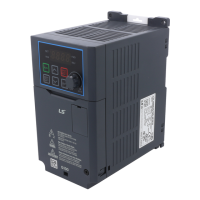When a dwell operation is carried out for a lift - type load before its mechanical brake is
released, motors can be damaged or their lifecycle reduced due to overflow current in the
motor.
5.7 Slip Compensation Operation
Slip refers to the variation between the setting frequency (synchronous speed) and
motor rotation speed. As the load increases there can be variations between the
setting frequency and motor rotation speed. Slip compensation is used for loads that
require compensation of these speed variations.
Slip Compensation Operation Setting Details
Set dr.09 to 2 (Slip Compen) to carry out the slip compensation
operation.
Set the capacity of the motor connected to the inverter.
Enter the number of poles from the motor rating plate.
Enter the number of rated rotations from the motor rating plate.
Enter the rated current from the motor rating plate.
Enter the measured current when the load on the motor axis is
removed and when the motor is operated at the rated frequency. If
no-load current is difficult to measure, enter a current equivalent to
30–50% of the rated motor current.

